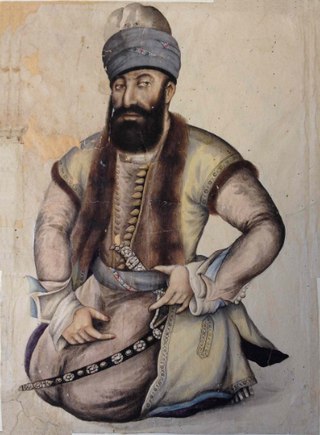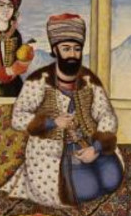Related Research Articles

Agha Mohammad Khan Qajar, also known by his regnal name of Agha Mohammad Shah, was the founder of the Qajar dynasty of Iran, ruling from 1789 to 1797 as Shah. Originally a chieftain of the Quwanlu branch of the Qajar tribe, Agha Mohammad Khan was enthroned as the king of Iran in 1789, but was not officially crowned until March 1796, having deposed Lotf Ali Khan of the Zand dynasty in 1794. Agha Mohammad Khan Qajar was famously the eunuch Monarch, being castrated as a young adult upon his capture by Adel Shah Afshar, and hence was childless. He was assassinated on 17 June 1797, and was succeeded by his nephew, Fath-Ali Shah Qajar.

Mohammad Shah was the third Qajar shah of Iran from 1834 to 1848, inheriting the throne from his grandfather, Fath-Ali Shah. From a young age, Mohammad Mirza was under the tutelage of Haji Mirza Aqasi, a local dervish from Tabriz whose teachings influenced the young prince to become a Sufi-king later in his life. After his father Abbas Mirza died in 1833, Mohammad Mirza became the crown prince of Iran and was assigned with the governorship of Azarbaijan. After the death of Fath-Ali Shah in 1838, some of his sons including Hossein Ali Mirza and Ali Mirza Zel as-Soltan rose up as claimants to the throne. With the support of English and Russian forces, Mohammad Shah suppressed the rebellious princes and asserted his authority.

Mohammad Karim Khan Zand was the founder of the Zand Dynasty, ruling from 1751 to 1779. He ruled all of Iran (Persia) except for Khorasan. He also ruled over some of the Caucasian lands and occupied Basra for some years.

The Zand dynasty was an Iranian dynasty, founded by Karim Khan Zand that initially ruled southern and central Iran in the 18th century. It later quickly came to expand to include much of the rest of contemporary Iran as well as parts of Iraq. The lands of present-day Armenia, Azerbaijan, and Georgia were controlled by khanates which were de jure part of the Zand realm, but the region was de facto autonomous. The island of Bahrain was also held for the Zands by the autonomous Al-Mazkur sheikhdom of Bushire.

Mohammad-Ali Mirza Dowlatshah was a famous Iranian Prince of the Qajar dynasty. He is also the progenitor of the Dowlatshahi Family of Persia. He was born at Nava, in Mazandaran, a Caspian province in the north of Iran. He was the first son of Fath-Ali Shah, the second Qajar king of Persia, and Ziba Chehr Khanoum, a Georgian girl of the Tsikarashvili family. He was also the elder brother of Abbas Mirza. Dowlatshah was the governor of Fars at age 9, Qazvin and Gilan at age 11, Khuzestan and Lorestan at age 16, and Kermanshah at age 19.
Abol-Fath Khan Zand was the third Shah of the Zand dynasty, ruling from March 6, 1779, until August 22, 1779.

Jafar Khan Zand, was the seventh shah (king) of the Zand dynasty of Iran from 1785 to 1789. He was the son of Sadiq Khan Zand, who was removed from the throne in Shiraz by Ali Murad Khan, who had previously taken Isfahan for himself.

Sadeq Khan Zand, also known as Mohammad Sadeq, was the fourth Shah of the Zand dynasty of Iran from August 22, 1779 until March 14, 1781.

Ali-Morad Khan Zand was fifth ruler of the Zand dynasty of Iran, ruling from March 15, 1781, until February 11, 1785.

The Nakhichevan Khanate was a khanate under Iranian suzerainty, which controlled the city of Nakhichevan and its surroundings from 1747 to 1828.
Azād Khān Afghān, or Azād Shāh Afghān, was a Pashtun military commander and a major contender for supremacy in western Iran after the death of Nader Shah Afshar in 1747. Azad rose to power between 1752 and 1757, and had his power base in the Azarbaijan region. Azad was a contemporary of Ahmad Shah Durrani, the founder of the Durrani Empire.
Fath-Ali Khan Afshar, was a chieftain from the Afshar tribe of Urmia, and one of the four contenders for supremacy in Iran between 1751–1763. He was ultimately defeated and captured in February 1763 by one of the contenders, the Zand ruler Karim Khan Zand. The latter had Fath-Ali Khan executed the following year, in July 1764.
Zaki Khan Zand was an Iranian military commander and contender for the throne. A member of the Zand Dynasty of Iran, Zaki Khan, though he never became the ruler of Iran, managed to exert power over the country during the three months between the death of his half-brother Karim Khan, on March 2, 1779, and his own brutal death.

Hajji Ebrahim Shirazi, also known by his honorific title E'temad ol-Dowleh, was an Iranian statesman who served as the kalantar of the city of Shiraz during the late Zand era and later as the first grand vizier of Qajar Iran.

Lotf Ali Khan was the last Shah of the Zand dynasty. He ruled from 1789 to 1794.
Ali Mardan Khan Bakhtiari was the Bakhtiari supreme chieftain (ilkhani) of the Chahar Lang branch, and major contender for supremacy in western Iran after the death of Nader Shah in 1747.

Shaykh Ali Khan Zand was a Zand nobleman, who was a close associate and prominent lieutenant of his cousin Karim Khan Zand. However, he later clashed with the latter, who had him blinded. He afterwards lived the rest of his life as an honored representative of the court, until a civil war occurred after Karim Khan's death in 1779, where Shaykh Ali Khan was killed by his cousin, Zaki Khan Zand.
Hossein Qoli Khan Qajar was the Qajar chieftain of the Qoyunlu branch from 1759 till his death in 1777 and brother of the founder of the Qajar dynasty of Iran Agha Mohammad Khan Qajar.
Ali-Qoli Khan Qajar was a son of Mohammad Hasan Khan Qajar and half-brother of Agha Mohammad Khan Qajar, the founder of the Qajar dynasty of Iran. Unlike Agha Mohammad Khan's full brothers, Ali-Qoli Khan served loyally from the outset and supported, for around twenty years, Agha Mohammad Khan's conquest for control over all of Iran. Following Agha Mohammad Khan's assassination in 1797, he unsuccessfully tried to claim himself as his brother's rightful successor. Ali-Qoli Khan was eventually blinded and exiled by his nephew Baba Khan, who would ascend the Iranian throne as Fath-Ali Shah Qajar.
The Battle of Astarabad was fought outside the city of Astarabad on February 14, 1759, by the forces of Karim Khan Zand, commanded by Shaykh Ali Khan Zand and Mohammad Hasan Khan Qajar. The battle resulted in a total Qajar defeat and caused the death of Mohammad Hasan Khan Qajar, ending the Qajar threat to the Zand dynasty until the conquest of Agha Mohammad Khan Qajar.
References
- ↑ Perry, John (2016). "Zand Dynasty". Encyclopædia Iranica, online edition. Retrieved 14 October 2018.
- ↑ The young children of Karim Khan Zand were neither designated Shah nor Wakil, but called in Persian sources "Khan", in European sources "King"; cf Perry, Zand Dynasty
- ↑ W. William Bayne Fisher; P. Avery; G. R. G. Hambly; C. Melville (10 October 1991). The Cambridge History of Iran. Vol. VII. Cambridge University Press. p. 93. ISBN 978-0-521-20095-0 . Retrieved 28 July 2013.